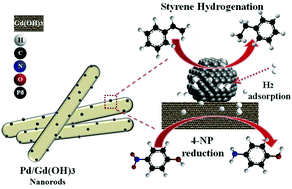Our official English website, www.x-mol.net, welcomes your feedback! (Note: you will need to create a separate account there.)
Highly dispersed ultra-small Pd nanoparticles on gadolinium hydroxide nanorods for efficient hydrogenation reactions
Nanoscale ( IF 6.7 ) Pub Date : 2017-09-11 00:00:00 , DOI: 10.1039/c7nr05096h Naseeb Ullah 1, 2, 3, 4, 5 , M. Imran 1, 2, 3, 4, 5 , Kuang Liang 1, 2, 3, 4, 5 , Cheng-Zong Yuan 1, 2, 3, 4, 5 , Akif Zeb 1, 2, 3, 4, 5 , Nan Jiang 1, 2, 3, 4, 5 , Umair Yaqub Qazi 1, 2, 3, 4, 5 , Shafaq Sahar 1, 2, 3, 4, 5 , An-Wu Xu 1, 2, 3, 4, 5
Nanoscale ( IF 6.7 ) Pub Date : 2017-09-11 00:00:00 , DOI: 10.1039/c7nr05096h Naseeb Ullah 1, 2, 3, 4, 5 , M. Imran 1, 2, 3, 4, 5 , Kuang Liang 1, 2, 3, 4, 5 , Cheng-Zong Yuan 1, 2, 3, 4, 5 , Akif Zeb 1, 2, 3, 4, 5 , Nan Jiang 1, 2, 3, 4, 5 , Umair Yaqub Qazi 1, 2, 3, 4, 5 , Shafaq Sahar 1, 2, 3, 4, 5 , An-Wu Xu 1, 2, 3, 4, 5
Affiliation

|
Heterogeneous catalytic hydrogenation reactions are of great importance to the petrochemical industry and fine chemical synthesis. Herein, we present the first example of gadolinium hydroxide (Gd(OH)3) nanorods as a support for loading ultra-small Pd nanoparticles for hydrogenation reactions. Gd(OH)3 possesses a large number of hydroxyl groups on the surface, which act as an ideal support for good dispersion of Pd nanoparticles. Gd(OH)3 nanorods are prepared by hydrothermal treatment, and Pd/Gd(OH)3 catalyst with a low loading of 0.95 wt% Pd is obtained by photochemical deposition. The catalytic hydrogenation of p-nitrophenol (4-NP) to p-aminophenol (4-AP) and styrene to ethylbenzene is performed as a model reaction. The obtained Pd/Gd(OH)3 catalyst displays excellent activity as compared to other reported heterogeneous catalysts. The rate constant of 4-NP reduction is measured to be 0.047 s−1 and the Pd/Gd(OH)3 nanocatalyst shows no marked loss of activity even after 10 consecutive cycles. Additionally, the hydrogenation of styrene to ethylbenzene over Pd/Gd(OH)3 nanorods exhibits a turnover frequency (TOF) as high as 6159 h−1 with 100% selectivity. Moreover, the catalyst can be recovered by centrifugation and recycled for up to 5 consecutive cycles without obvious loss of activity. Our results indicate that Gd(OH)3 nanorods act as a promoter to enhance the catalytic activity by providing a synergistic effect from the strong metal support interaction and the large surface area for high dispersion of small sized Pd nanoparticles enriched with hydroxyl groups on the surface. The high performance of Pd/Gd(OH)3 in heterogeneous catalysis offers a new, efficient and facile strategy to explore other metal hydroxides or oxides as supports for organic transformations.
中文翻译:

在氢氧化g纳米棒上高度分散的超小Pd纳米颗粒,可进行有效的氢化反应
非均相催化氢化反应对石化工业和精细化学合成非常重要。在这里,我们提出了氢氧化((Gd(OH)3)纳米棒的第一个例子,作为负载超小型Pd纳米颗粒用于氢化反应的载体。Gd(OH)3在表面上具有大量羟基,可作为Pd纳米颗粒良好分散的理想载体。通过水热处理制备Gd(OH)3纳米棒,并通过光化学沉积获得Pd / Gd(OH)3催化剂,其Pd负载量低,为0.95 wt%。对硝基苯酚(4-NP)催化加氢成p作为模型反应,进行-氨基苯酚(4-AP)和苯乙烯至乙苯的反应。与其他报道的非均相催化剂相比,所获得的Pd / Gd(OH)3催化剂显示出优异的活性。测量出4-NP还原的速率常数为0.047s -1,并且即使在连续10个循环之后,Pd / Gd(OH)3纳米催化剂也没有显示出明显的活性损失。另外,在Pd / Gd(OH)3纳米棒上将苯乙烯氢化成乙苯的反应频率(TOF)高达6159 h -1,选择性为100%。此外,可以通过离心回收催化剂,并循环使用多达5个连续循环,而不会明显降低活性。我们的结果表明,Gd(OH)3纳米棒通过增强的金属载体相互作用和较大的表面积提供协同效应,从而增强催化活性,从而促进了表面上富含羟基的小尺寸Pd纳米颗粒的高分散性。Pd / Gd(OH)3在非均相催化中的高性能为探索其他金属氢氧化物或氧化物作为有机转化的载体提供了一种新的,高效且简便的策略。
更新日期:2017-09-21
中文翻译:

在氢氧化g纳米棒上高度分散的超小Pd纳米颗粒,可进行有效的氢化反应
非均相催化氢化反应对石化工业和精细化学合成非常重要。在这里,我们提出了氢氧化((Gd(OH)3)纳米棒的第一个例子,作为负载超小型Pd纳米颗粒用于氢化反应的载体。Gd(OH)3在表面上具有大量羟基,可作为Pd纳米颗粒良好分散的理想载体。通过水热处理制备Gd(OH)3纳米棒,并通过光化学沉积获得Pd / Gd(OH)3催化剂,其Pd负载量低,为0.95 wt%。对硝基苯酚(4-NP)催化加氢成p作为模型反应,进行-氨基苯酚(4-AP)和苯乙烯至乙苯的反应。与其他报道的非均相催化剂相比,所获得的Pd / Gd(OH)3催化剂显示出优异的活性。测量出4-NP还原的速率常数为0.047s -1,并且即使在连续10个循环之后,Pd / Gd(OH)3纳米催化剂也没有显示出明显的活性损失。另外,在Pd / Gd(OH)3纳米棒上将苯乙烯氢化成乙苯的反应频率(TOF)高达6159 h -1,选择性为100%。此外,可以通过离心回收催化剂,并循环使用多达5个连续循环,而不会明显降低活性。我们的结果表明,Gd(OH)3纳米棒通过增强的金属载体相互作用和较大的表面积提供协同效应,从而增强催化活性,从而促进了表面上富含羟基的小尺寸Pd纳米颗粒的高分散性。Pd / Gd(OH)3在非均相催化中的高性能为探索其他金属氢氧化物或氧化物作为有机转化的载体提供了一种新的,高效且简便的策略。



























 京公网安备 11010802027423号
京公网安备 11010802027423号